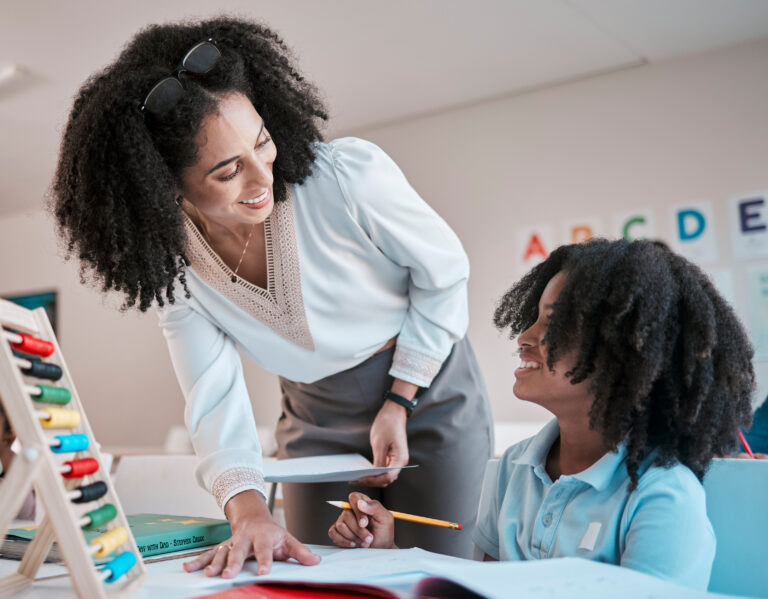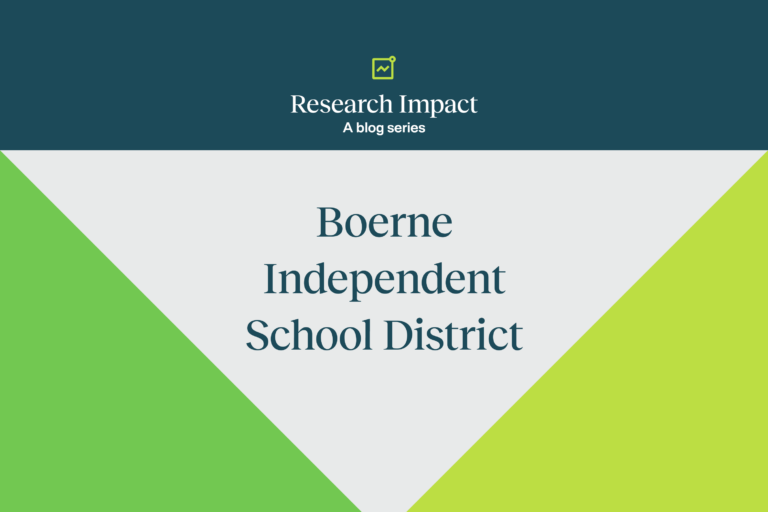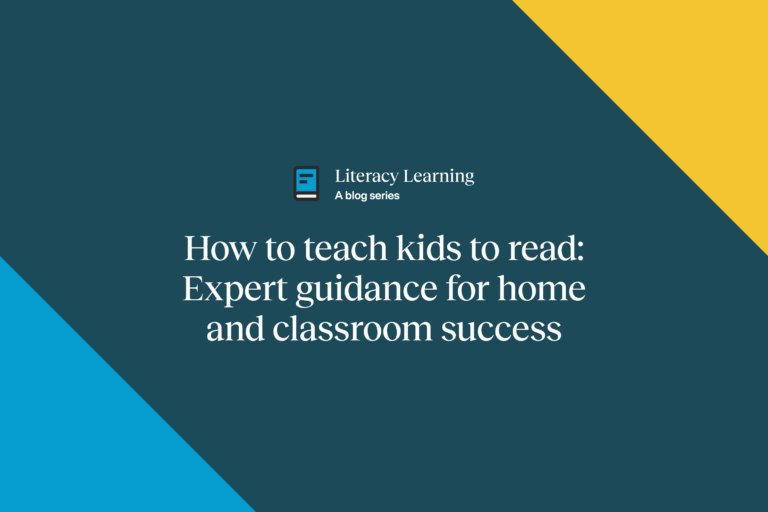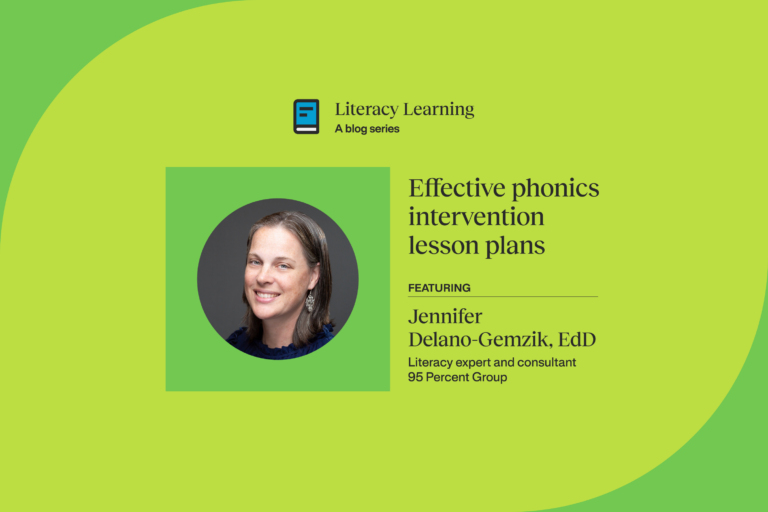Syllable awareness: A guide for teachers and parents

A guide to syllable awareness
There are many building blocks to reading readiness. Syllable awareness, which falls under the phonological awareness category, is one of the first “phonological sensitivity” skills a child develops. Developing this ability will serve a child well in further deepening their understanding of how spoken language works, ultimately leading to an understanding of the all-important phonemic awareness, or the ability to recognize and manipulate phonemes, the smallest units of sound. This phoneme awareness is a critical development in learning to read, as it underlies the understanding of the alphabetic code.
Reading this article will help guide you towards understanding syllable awareness, the role it plays in reading, and how you can support the development of this skill.
What is syllable awareness?
Syllable awareness is a phonological sensitivity skill that ultimately helps prepare students for studying smaller units of sound, or phonemic awareness. When children first begin to understand spoken language, they start at the word level. They understand that each word they say represents something real. An example would be understanding the word cat represents the furry animal that says, “Meow.”
Once children understand this, they typically start to develop an understanding of syllables within words, or at the syllable level. A syllable is essentially a word part. For one-syllable words, like snap or beach, understanding the orthographic patterns in the one syllable allows a child to figure out the word. But when there are multisyllabic words, it’s necessary to understand where the word breaks apart and is organized around the vowels in order to pronounce and understand its meaning correctly.
When students have syllable awareness, they can correctly recognize and pronounce syllables within words. Ultimately, this helps create a strong foundation for decoding multisyllabic words and understanding stress patterns—creating the rhythm and flow of spoken language. While this work begins in preschool with understanding and learning, different words have a different number of syllables, the more complex parts of syllable awareness—namely the written language skill of the six syllable types, aren’t taught until later, when children are decoding at least one-syllable words. Phonological awareness is truly a foundational literacy skill that can’t be skipped.
Syllable types:
Explicitly teaching students the six different types of syllables gives them the foundation they need to understand how words are pronounced and how to interpret language. Understanding syllable types helps students recognize patterns in the written language. This helps them in decoding and is especially helpful (along with morphology) in helping them decode and understand more complex multisyllabic words.
Explicitly teaching students the six different types of syllables gives them the foundation they need to understand how words are pronounced and how to interpret language. Understanding syllable types helps students recognize patterns in the written language. This helps them in decoding and is especially helpful (along with morphology) in helping them decode and understand more complex multisyllabic words.
Syllable Type 1: Closed syllables are syllables whose vowels are “closed off” by a consonant on the end; this tells us that the vowel is pronounced with its “short vowel” sound.
Examples: dog, magnet, napkin, cobweb, muffin
Syllable Type 2: Vowel-consonant-e (VCe) syllables have a vowel followed by a consonant and end with a silent e. The e at the end of the word signals to readers that the vowel is pronounced with its elongated or open sound.
Examples: kite, gate, note, these, cute
Syllable Type 3: Open syllables have a vowel that isn’t “closed” by a consonant. When a vowel is on the end of a syllable, it is pronounced with its elongated or long vowel sound.
One syllable words: me, hi, by,
Two syllable words (first syllable is open): bacon, begin, music, solo
Syllable Type 4: Vowel Team or Vowel Digraph have two vowels that work together to make one sound. Often, but not always, the rule is that when you have two vowels together, the vowel we hear is the one that comes first, and makes its long vowel sound (usually, its letter name).
Examples: boat, eat, beach, paint
Other times, there are two vowels together that each make a distinct sound like in words lion, fluent, and rodeo.
Syllable Type: R-Controlled means the syllable has a vowel followed by the /r/ sound. The /r/ changes the sound of the original vowel—so it is not a short or long sound, rather it is controlled by the /r/ sound (ar, er/ir/ur, or).
Examples: car, her, girl, furnace, former
Syllable Type: Consonant-Le syllables, sometimes called the stable final syllable, are only found at the end of a word that has more than one syllable. The C-Le syllable is pronounced by combining the final consonant and the /l/ sound. If the first syllable is open (bugle: pronounced /b/-/ū/-/g/-/ul/ or byoo-gl, cable, title, whistle), you do not need to double the final consonant. If the first syllable is a closed (little, dabble, bubble) it requires doubling the final consonant.
Building syllable awareness skills
When children first start to recognize syllables, using movement, rhythm, or music wherever possible is a great way to help them really feel or embody syllabication. Syllable sensitivity is enhanced through language play that is a natural part of preschool and kindergarten. There are various ways to incorporate this into classroom activities, small group work or one-on-one lessons.
Here are a few ways to engage in language play to support phonological sensitivity, including syllable awareness:
- Encourage active listening when reading aloud to students. Ask students to hold up their thumb or their hand every time they hear a certain characteristic of phonological awareness—a great example is hearing words that rhyme.
- Building on this activity, you can stop and think while reading aloud. Example, “hmmm I just heard the word box. I wonder what words rhyme with box? Put your thumb up if you know a word that rhymes with box!” Then, you can call on different students to show what they know.
- Clapping, snapping, stomping, or jumping to identify how many syllables are in a word. Example: How many syllables are in the word “stuck?” Have students clap/jump one time for the one-syllable word. How many syllables are in the word “pencil?” Have students stomp two times for the two-syllable word.
- Tapping out syllables in names. While lining up for recess or to go home, use a drum or surface to tap out the syllables or a bell or triangle to make a sound for each as you call each student’s name to line up. Example, “Mad-e-line,” tapping each syllable as you say it. “O-liv-i-a.” Have students repeat after you or tell you how many syllables are in their name as they arrive in the line.
- Underlining and marking each syllable type (older students). Have kids divide words into syllables and mark where the vowels are short or long. This helps students see where words divide and how to properly pronounce them. Bonus points if they can identify what type of syllable it is.
Syllable awareness across curriculum
Like other foundational reading skills, it’s important for children to get practice with syllable awareness outside of just their core reading instruction. There are many ways to incorporate working on syllables during different parts of a student’s day—whether in kindergarten or middle school.
Reading and writing poetry
Writing poetry is a great example of how educators can scaffold syllable awareness. For younger children, teachers can read aloud, or children can read a simple passage and look for words that are in the same word family. Alternatively, children can raise 1 or 2 or 3 fingers etc., when they hear a multisyllabic word.
For older students, writing Haiku is an excellent way to draw attention to syllables. Haiku requires three lines of 5, 7, and then 5 syllables, respectively. By adjusting the topic of the poems, Haiku can be integrated into any subject area, from science to history to foreign language.
Multisyllabic word identification and syllable division
A great activity for students reading text that contains more sophisticated or academic language is to pull out the multisyllabic words from the text and have students work on syllable division with that set of words. The instructor can choose words ahead of time or the students can identify those words that have 3 or more syllables or that they don’t recognize or understand.
An example might be the word “photosynthesis.” Once students have been explicitly taught syllibication, there are different activities they can do for independent practice. For example:
- Have students highlight multisyllabic words as they read a passage
- Then they can write each word in their notebook or on a sticky note.
- Then they can mark the places where the word should divide into syllables: (pho·to·syn·the·sis) and read aloud to see if it sounds correct. Sometimes hearing a word aloud that students already have in their vocabulary can help them decide if they’ve divided it correctly or need to try again.
Using music to support syllable awareness
When we listen to music, it’s common to tap our feet or nod our head to the beat. You can have the students shift their awareness from the beat of the music to the “beat” or rhythm of the words. This will allow students to understand that music is really a lot like poetry and requires understanding syllabication and the flow of language to incorporate lyrics into songs.
Supporting children at different levels
While the order in which literacy skills are developed is generally the same from student to student, the rate or pace at which students acquire skills can vary greatly. It’s important to recognize that how skills are presented and received can be a helpful anchor to organize your instructional strategy.
Some children may understand syllabication by hearing words and clapping the syllables. Others may need to have more physical feedback in order to feel it in their bodies. Still other students may learn best by listening to music or beating the rhythm of words on a drum. The important part is that they find what works best for them and that we as educators meet them where they are to take them where they need to go.
The final word
Syllable awareness is both one of the very first skills children develop as they begin to understand the nuances of spoken language, and it’s also a more complex skill as they work with written language and reading to learn academically. The foundations of language acquisition set the stage for reading and writing success; every step on the way to a strong start is critical.
95 Phonemic Awareness Suite™ begins this work with the youngest students, helping those who need extra support in learning the first foundational skills to prepare them for phonics instruction. For students in the mid to upper elementary grades, there are products like the Multisyllable Routine Cards Package, which explicitly teaches the six syllable types, and 95 Vocabulary Surge™, which teaches students how to break apart words into their parts.
Sources
- Moats, Louisa. “How Spelling Supports Reading.” American Federation of Teachers, 2005. Accessed January 19, 2024. https://www.aft.org/sites/default/files/Moats.pdf.
- Reading Rockets. “Six Syllable Types | Reading Rockets,” n.d. https://www.readingrockets.org/topics/spelling-and-word-study/articles/six-syllable-types.



